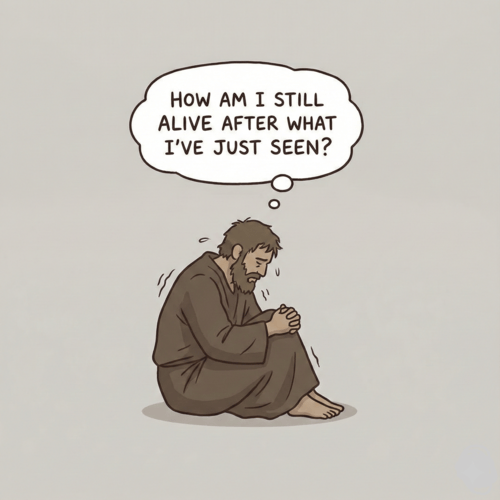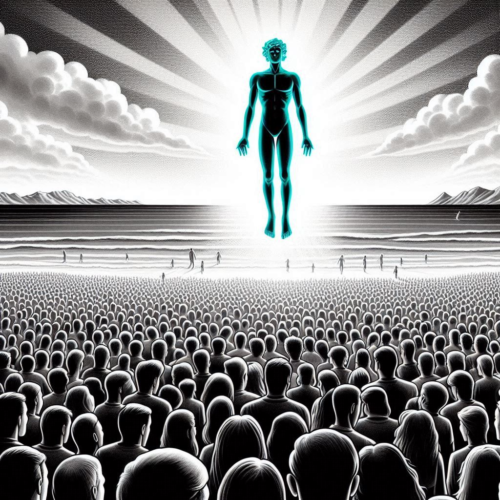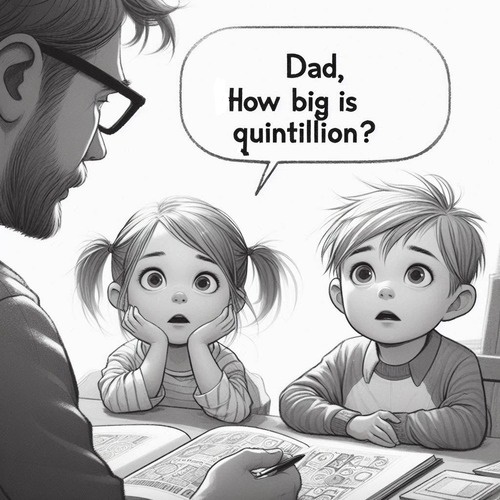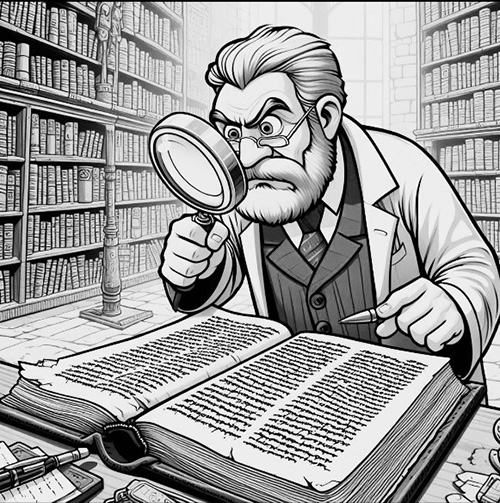The Necessary Adam: Why We Must Affirm the First Man
In an age where evolutionary accounts of human origins dominate secular thinking, many Christians find themselves tempted to reinterpret Adam as a symbolic figure rather than a historical person. This compromise may seem harmless at first glance, but as this post demonstrates, the historicity of Adam isn’t merely a peripheral issue for us, Christians,—it’s foundational to our faith.
THE BIBLICAL TESTIMONY
Scripture speaks with remarkable clarity about Adam as a real individual. Genesis presents Adam’s creation with specific detail: “The LORD God formed the man of dust from the ground and breathed into his nostrils the breath of life” (Genesis 2:7). We read of his naming of animals, his relationship with Eve, and his fall into sin—all narrated as historical events, not metaphorical lessons.
This historical understanding continues throughout Scripture. Luke traces Jesus’ genealogy back to “Adam, the son of God” (Luke 3:38). Paul declares, “sin came into the world through one man” (Romans 5:12). Jesus Himself refers to the creation of Adam and Eve as historical reality: “Have you not read that he who created them from the beginning made them male and female…?” (Matthew 19:4). These references aren’t casual or incidental—they form the backbone of critical biblical arguments.
WHY ADAM’S HISTORICITY MATTERS
The Reality of Sin and Death: Paul’s argument in Romans 5 hinges on Adam’s historical reality: “Just as sin came into the world through one man, and death through sin, and so death spread to all men” (Romans 5:12). If Adam wasn’t a real person who committed a real sin, the biblical explanation for sin and death collapses. The Reformed doctrine of original sin—that we inherit both Adam’s guilt and corruption—requires a historical Adam who represents humanity as our federal head in a real covenant relationship with God.
Christ as the Second Adam: Perhaps most critically, Scripture presents Christ as the “last Adam” (1 Corinthians 15:45). Paul builds a powerful parallel: “For as by the one man’s disobedience the many were made sinners, so by the one man’s obedience the many will be made righteous” (Romans 5:19). This comparison isn’t merely illustrative—it’s foundational to understanding Christ’s work. If the first Adam is mythical, what does this say about the second Adam? The historical reality of redemption depends on the historical reality of the fall.
The Authority of Scripture: Jesus and the apostles consistently treated Adam as historical. When we reject this teaching, we’re implicitly claiming to know better than Christ Himself. This approach undermines the authority of Scripture, creating a dangerous precedent where we can dismiss any biblical teaching that conflicts with the current scientific or cultural consensus.
The Image of God: Genesis teaches we were uniquely created in God’s image (Genesis 1:26-27)—the doctrine that grounds human dignity and worth. An evolutionary account that denies Adam’s special creation threatens this foundation, suggesting instead humanity emerged gradually through natural processes without a distinct moment of divine image-bearing creation.
ADDRESSING COMMON OBJECTIONS
Some argue Genesis is simply ancient Near Eastern literature that was never intended to be read as history. But this view fails to account for how the rest of Scripture treats these texts. Others suggest scientific evidence makes a historical Adam impossible. However, the limitations of scientific methodology in addressing historical singularities should give us pause. Science cannot prove or disprove unique historical events, especially those involving divine intervention.
Others suggest we can maintain the “theological meaning” while abandoning historicity. But this creates an artificial separation between history and theology that Scripture itself doesn’t recognise. In biblical thinking, redemptive history is real history—the meaning is inseparable from the events.
THE NECESSARY ADAM: PRACTICAL IMPLICATIONS
Affirming Adam’s historicity isn’t merely an academic exercise—it shapes our entire understanding of the gospel. It explains why we need salvation in the first place. It helps us understand the depth of our sin problem. It magnifies the glory of Christ’s work as the second Adam who succeeds where the first Adam failed.
This doctrine provides hope, too. Just as we were truly represented by Adam in his fall, we are truly represented by Christ in His obedience. The historical reality of both Adams assures us our salvation is grounded in real events, not merely in inspiring stories.
CONCLUSION: THE NECESSARY ADAM
The historicity of Adam isn’t negotiable for biblical Christianity. It’s woven into the fabric of Scripture’s narrative and theology. When we affirm a historical Adam, we affirm the reliability of Scripture, the reality of sin, and the necessity of Christ’s redemptive work. In doing so, we stand with Jesus and the apostles in recognising our faith is built not on cleverly devised myths but on the firm foundation of God’s work in real human history.
“For as by a man came death, by a man has come also the resurrection of the dead. For as in Adam all die, so also in Christ shall all be made alive.” (1 Corinthians 15:21-22)
THE NECESSARY ADAM: RELATED FAQs
Could Adam have been the head of just one tribe of early human beings rather than the father of all humanity? This view contradicts Scripture’s clear teaching that all humans descend from Adam and that through him sin entered the human race (Acts 17:26, Romans 5:12). The Reformed understanding holds that Adam was not merely a tribal leader but the federal head of all humanity, whose sin and guilt are imputed to all his descendants, which necessitates his position as the biological ancestor of all people.
- How do we understand the relationship between Adam and ancient human-like fossil remains? From a Reformed perspective, we must distinguish between anatomically human-like creatures that may have existed before Adam and true human beings created in God’s image. Any pre-Adamic hominids, if they existed, would not have been image-bearers and should not be confused with Adam and Eve. Scripture’s primary concern is theological anthropology—defining human beings by their relationship to God rather than merely by physical characteristics.
- Why does Reformed theology place such emphasis on Adam when many other Christian traditions have adopted symbolic interpretations? Reformed theology emphasises the federal headship principle, covenant theology, and the absolute authority of Scripture—all of which require a historical Adam. Unlike traditions that may prioritise harmonisation with contemporary scientific consensus, Reformed theology insists Scripture interprets Scripture and that later biblical authors’ understanding of Adam (particularly Paul’s) must govern our interpretation. Reformed theology’s emphasis on God’s sovereignty in salvation also connects deeply with understanding Adam’s federal headship.
- How does affirming Adam’s historicity affect our understanding of the image of God? A historical Adam establishes that the image of God was bestowed in a specific creative act rather than emerging gradually through evolutionary processes. This affirms the distinct ontological status of human beings as fundamentally different from animals—not merely more evolved—and grounds human dignity in God’s deliberate design rather than natural development. Reformed theology sees the image of God as marred but not destroyed by the Fall, providing the basis for common grace extending to all Adam’s descendants regardless of their spiritual state.
- If we affirm a historical Adam, how should Christians approach scientific research on human origins? Christians engage science with both confidence in Scripture’s authority and humility about human interpretations of both Scripture and scientific data. Reformed epistemology recognises all human thinking is affected by sin, meaning scientific paradigms (like all human knowledge) are provisional and subject to revision in light of Scripture. Christians can participate in scientific research while maintaining that methodological naturalism has inherent limitations when addressing origins, and that divine special creation falls outside its investigative capabilities.
- How does Adam’s historicity relate to the Reformed understanding of God’s covenants? In Reformed covenant theology, Adam was the covenant head in the Covenant of Works (or Covenant of Life), making his historical existence essential to understanding our current covenant situation. The historical Adam’s failure in the first covenant necessitated the Covenant of Grace, establishing the pattern of federal headship that reaches its fulfillment in Christ. Without a historical covenant with a historical Adam, the covenant structure that undergirds Reformed soteriology becomes merely a theological construct rather than God’s actual dealing with humanity in history.
What has been the traditional Reformed consensus on Adam’s historicity? The Reformed consensus, as articulated by leaders such as J Gresham Machen and RC Sproul has been that Adam’s historicity is non-negotiable for biblical Christianity. Sproul argued that Paul’s parallel between Adam and Christ in Romans 5 requires a historical first man. He wrote, “If Adam was not a real person, the premise of Paul’s argument is evacuated.” The rejection of a historical Adam has been seen as part of a dangerous accommodation to secular thought that ultimately undermines essential doctrines of sin and salvation. Kevin DeYoung has vigorously defended the traditional Reformed position on Adam as historically necessary for biblical theology. In his book Taking God At His Word and various articles, DeYoung argues rejecting Adam’s historicity creates a problematic hermeneutical precedent that threatens other biblical doctrines. In his comprehensive work The Christian Faith, Michael Horton defends Adam’s historicity as essential to covenant theology. The Covenant of Works with Adam establishes the framework for understanding Christ’s work, making Adam’s historical existence necessary for soteriology.
THE NECESSARY ADAM: OUR RELATED POSTS
Editor's Pick

The Throne-Room Vision: Who Did Isaiah See?
The scene is unforgettable: Isaiah stands in the temple, and suddenly the veil between heaven and earth tears open. He [...]

The Angel of the Lord: Can We Be Certain It Was Christ All Along?
Throughout the Old Testament, a mysterious figure appears: the Angel of the LORD. He speaks as God, bears God’s name, [...]
SUPPORT US:
Feel the Holy Spirit's gentle nudge to partner with us?
Donate Online:
Account Name: TRUTHS TO DIE FOR FOUNDATION
Account Number: 10243565459
Bank IFSC: IDFB0043391
Bank Name: IDFC FIRST BANK






